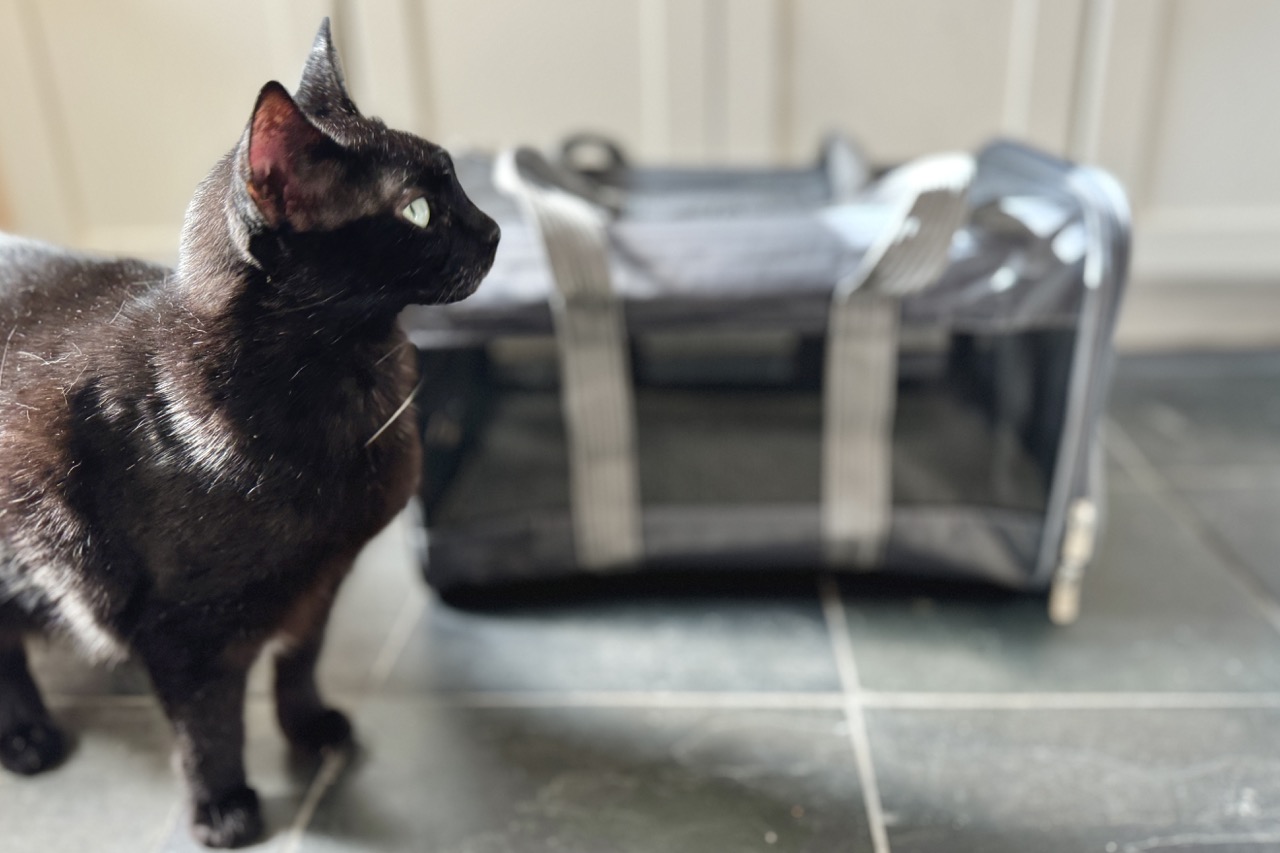Steps for Helping Your Cat Not Hate Going in the Cat Carrier (Or At Least Hate it Less)
Many cats would rather use one of their nine lives than willingly hop into a carrier and go for a car ride. But it doesn’t have to be this way!
With the right approach, you can teach your kitty to associate the carrier and car rides with positive experiences. Or at least make excursions to the vet a little less stressful. And not just for your cat, but for you too.
This article is the first in a two-part series on how to make outings less of an ordeal for your cat.
Carrier training and desensitization has two main components:
- Get a good quality carrier that’s comfortable and secure
- Help your cat build positive associations with it – in baby steps.
Below we’ll share what to do, step-by-step, to help your cat overcome anxieties around being in a carrier.
A Cat’s Perspective on Carriers and Cars
Let’s get inside the cat’s head for a moment. For them, carriers and car rides often mean one thing: a trip to the vet. And let’s be honest, that’s rarely a highlight of any cat’s day.
Cats tend to have a strong dislike for change in their environment. Obviously, a trip to the vet equals sudden drastic change and sensory overload, so the intense stress response many cats show is only natural.
Understanding this is the first step in transforming travel time from terrifying to tolerable, and eventually, maybe even enjoyable. Okay, probably not enjoyable, but we’ll reach for those lofty heights all the same!

Choose the Right Carrier
First of all, if you want to reduce travel stress for your cat, it’s actually very important to invest in a decent quality carrier. Here’s why.
The Problem with Cardboard Boxes and Cheap Carriers
It may be tempting to just use the cardboard box that you brought your cat home in on adoption day. I’ll confess that for a few years, I myself made this mistake because I didn’t know any better and thought a nice carrier was an unnecessary expense for someone on a tight budget.
But a cardboard box or carrier is problematic for a number of reasons:
Pitfalls of Using a Box or Cheap Car Carrier
- Not totally secure (escape risk)
- Not sturdy (feels unsafe to the cat)
- Slippery floor
- Not well ventilated
- Often too big or too small
- Only one opening
All of these factors create a nice recipe for maximizing a cat’s stress and discomfort, not to mention creating unnecessary risks of injury and escape. If your carrier doesn’t meet the basic requirements of comfort and security, then carrier and car desensitization training isn’t going to move the needle much for your cat.
On more than one occasion, I had a cat escape from the box during the drive. And one of those times, the cat ended up at my feet – not good!
If your carrier doesn’t meet the basic requirements of comfort and security, then carrier and car desensitization training isn’t going to move the needle much for your cat.
And unfortunately, the old school plastic crates with a metal door on one end aren’t a huge step up from the cardboard box. These carriers at least do a better job than boxes in terms of preventing escape. But you have to shove the cat in against their will, the plastic becomes brittle over time , and the floor is slippery.
What to Look For in a Carrier
First, consider carriers with multiple openings, including on the top. This can be a game-changer for coaxing your cat in and out without too much of a fuss. You also want it to have a sturdy, non-slippery floor, be big enough to turn around in, and have good ventilation.
Here’s a quick checklist for carrier features to consider:
Features to Look For in a Cat Carrier
- Size: Just enough space to turn around in
- Comfort: Washable bedding and non-slip floor
- Ventilation: Ample air circulation for comfort
- Durability: Sturdy build, rigid floor, and high quality zippers or latches
- Accessibility: Multiple doors or openings for easy access
- Carry-ability: A strong carrying handle that won’t cut into your hand
My Own Experience in Finally Upgrading My Pet Carrier
For years after I stopped using cardboard boxes, I still had only old hand-me-down carriers that I got from friends. They’re plastic, with a hinged metal door on the front and a plastic handle on top.
While they were absolutely more secure than cardboard, the single opening and slippery floor were major drawbacks, and the plastic was brittle and starting to crack.
When I switched to a high quality carrier, I wished I’d done it much sooner. Both transitioning a cat into the carrier and the car ride instantly became significantly less stressful for the cats and myself.
Affiliate Disclosure: VerveCat is supported by readers. As a member of Amazon Associates and other affiliate programs, we may earn a commission at no added cost to you when you follow a product link and make a purchase.
The Carrier I Use Now
After researching carrier options, I opted for the Sherpa Deluxe (Amazon) pet carrier. I love it for the following reasons:
- Two openings, including top (so much easier getting my cats in this way).
- High quality zippered openings are easy to manipulate and close securely.
- Sturdy, faux lambskin lined floor means no more slippery footing during transit.
- Collapsible for lower storage footprint.
- Well ventilated.
- Washable (including the furry floor lining).
- Big enough for my biggest cat (Gandalf, 14 pounds) but not too big for my smaller ones (Bean and Phoebe, 10 pounds). It’s also big enough to put a small item in with the cat that already smells familiar.
- Has an external zippered pouch that I can put a notebook or receipt in at the vet’s office.
- The soft handles and shoulder strap are way more comfortable for carrying than the hard plastic handle on traditional plastic carriers, which used to cut into my hand.
I can’t emphasize enough the difference it makes to be able to set the cat into the carrier from above, rather than making them go in through an opening on the end.
You’ll notice that many of the reasons I like this carrier are aligned with the qualities to look for that are mentioned above. Whether you get what I have or not, make sure your carrier choice meets the criteria provided earlier.
Create Positive Associations with the Carrier
Now that you’ve snagged the perfect carrier, it’s time to create some positive associations with it.
Start by placing it in your cat’s favorite room, with the door(s) wide open, and let curiosity take the lead. Sprinkle some favorite treats inside, or lay down a familiar blanket. You might need to start by placing treats near, rather than inside.
The goal is to have your cat view the carrier as a cozy retreat.
You can then feed meals near the carrier, then right next to it, and eventually even inside it. And if they eventually take a nap in there? Jackpot!
Here’s an example log for tracking progress:
How to Track Carrier Training Progress – Example Log
- When: Note the time (e.g., Week 1)
- What: Note the thing you did (e.g., introduced carrier and put treats inside)
- How: Note how your cat behaved or responded to what you did (e.g., sniffed around but wouldn’t go in)
- Next: Note your plan for next time based on what your cat did this time (e.g., repeat Week 1. Try putting treats near carrier instead of inside)
Once your cat doesn’t think twice about going in the carrier, it’s time to work on closing your cat inside.
And once that goes smoothly, you can work on picking the carrier up and taking it somewhere. Start with taking it to another room and work your way up to carrying it outside.
Last Meows
Carrier desensitization training is something I wish I’d done myself when I first got my cats. There’s a big difference between traveling with a terrified cat vs a cat that doesn’t totally hate being in the carrier.
Once you’ve mastered the carrier, it’s time to move on to taming the car experience, which is the second part of this training series.
Key Takeaways
Invest in a good carrier, then help your cat build positive associations with it – in baby steps. Don’t rush or force anything.
